Art History
Fragonard’s ‘The Swing’ Is More Than Just a Frivolous Portrait of Flirtation
We took a closer look at this famous scene of romantic and erotic love.

We took a closer look at this famous scene of romantic and erotic love.

Katie White

Jean-Honoré Fragonard’s The Happy Accidents of the Swing—better known as The Swing—is a painting that reaches the frivolously delightful heights of the Rococo imagination.
A rosy-cheeked young woman adorned in a sumptuously ruffly pink gown rises high on a swing. As she ascends, her dress billowing around her, she kicks out her leg and, as she does, one of her dainty pink slippers sails off her foot into the air, a flirtatious undoing.
Painted sometime between 1767 and 1768, The Swing is a painting consummately devoted to visual pleasures. The swing, with its crimson seat, hangs within a lushly grown garden. Trees, gnarled and majestic, frame the leading lady’s form. Abundant rose bushes appear like petaled but prickly cushions beneath her. One notices, with a second glance, that the woman on the swing isn’t alone. Crouched in the bushes below the swing, a man, ostensibly her paramour, stares up at his beloved with starry-eyed adoration, even extending his hat (his view is seemingly up her skirts, a garter is visible to all). This flirtation is coy, the painting suggests. Shadowed by foliage, a guileless older man—perhaps a clergyman or her unwitting husband—can be seen behind the woman, pulling the swing’s system of ropes that send her higher and ever higher into the air.
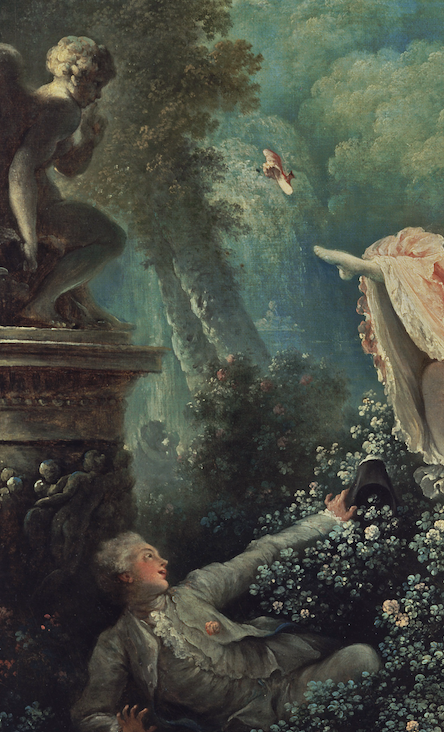
Detail of Fragonard’s The Swing.
The Swing has been both heralded and decried for its unbridled frivolity over the centuries—with controversy following it from its very inception. Fragonard was commissioned to paint The Swing by Baron Louis-Guillaume Baillet de Saint-Julien, a gentleman of the court, who wanted the artist to depict his mistress upon on a swing as he, the Baron, clandestinely admired her from below. The Baron had first approached the history painter Gabriel François Doyen from the commission, but Doyen, believing it too bawdy a subject, directed the aristocrat on to Fragonard. Fragonard, on the other hand, took up the commission with enthusiasm and The Swing would have an important impact on his career, allowing the artist to transition from history paintings of the court into the more lucrative and personal world of painting for the upper classes.
In 2021, The Swing—which is part of London’s Wallace Collection—went put back on view after a long-awaited cleaning (the painting hadn’t been cleaned in over 100 years), which restored the scene to its original sensually colorful glory. Coinciding with Valentine’s Day this week we’ve turned our gaze to Fragonard’s The Swing and have pinpointed three things that might help you see this saucy masterpiece in a new way.
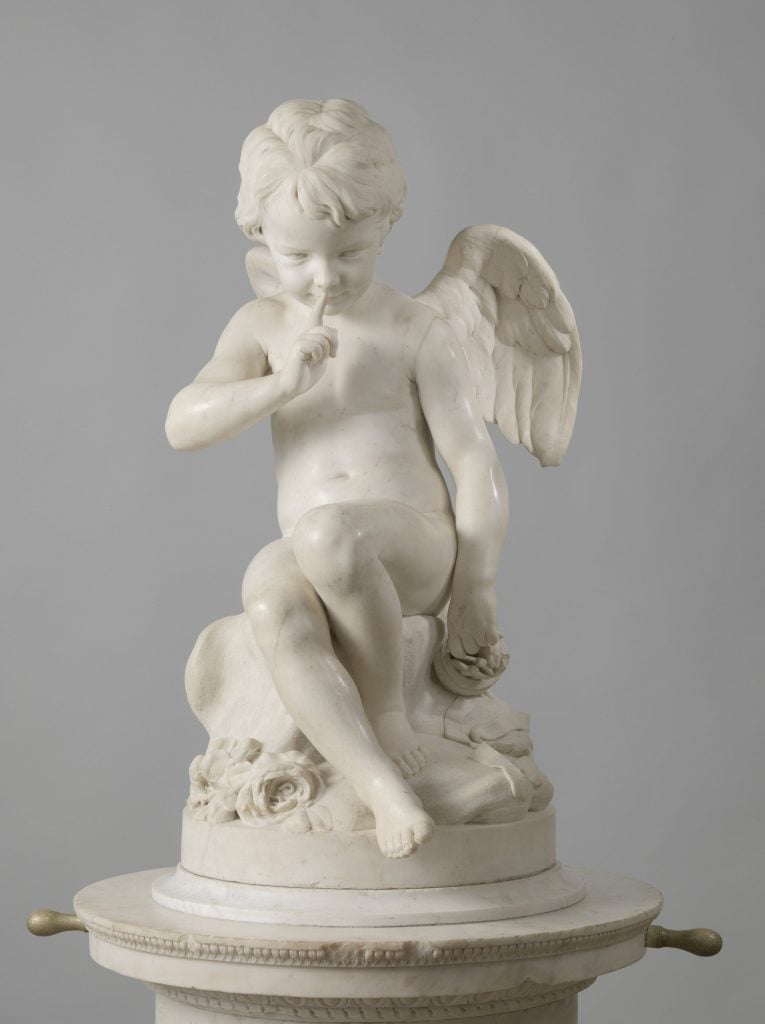
Étienne-Maurice Falcone, Menacing Cupid (1757). Collection Musée du Louvre.
For all its sense of whimsy, The Swing is an artfully staged composition. The painting’s setting—a wooded garden—has the look of a shrouded forest, far from civilization. Other details, however, remind the viewer the space is private, exclusive, and in some ways controlled. “The setting—staging is perhaps the better word—is calculated to carry specific meanings and so admits some naturalistic improbabilities,” wrote the art historian Donald Posner in his seminal 1982 essay “The Swinging Women of Watteau and Fragonard.”
In the background of the painting one can glimpse a faintly rendered fence, an indication that the space is off-limits to the wider public. The stone sculptures similarly hint at a private garden space. In 18th-century France, private gardens became popular among the aristocracy, as places where the parameters of propriety were often relaxed—and where it was possible for lovers to steal away for a moment. The overgrown flora, seemingly untamed in its growth, hints at the growing enthusiasm for the lush English-style garden, which was then gaining favor in France in place of the orderly traditional French garden. But nature’s bounty has other meanings too (Posner points out that a swing would not likely be installed near so many other trees). This natural setting instead creates “a mood of tremulous excitement by the dense twisting and turning of tree and bushes” and one in which the “image of nature’s luxuriance and fertility” would hint back at the young woman’s own fertility.
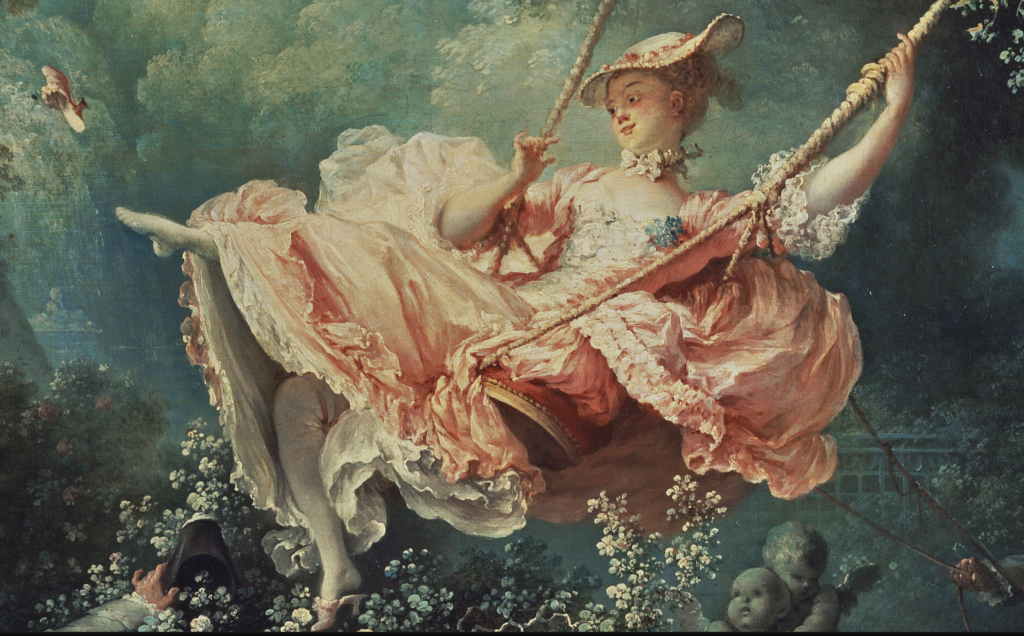
Detail of Fragonard’s The Swing.
But Fragonard always reminds us that the scene of fun-filled abandon exists within both societal and formal constraints—just as the ropes of the swing thrust the woman higher, they also pull her back. A sculpture of Cupid on the lower left emphasizes the fancifulness of the illicit situation and raises a finger to his mouth as though asking for quiet. The sculpture is a direct reference to Menacing Cupid (in the Musée du Louvre) by Étienne-Maurice Falconet which was made for Louis XV’s mistress Madame Pompadour (the sculpture was celebrated at the Salon of 1757). Cupid’s gesture—and this reference—playfully hints that the relationship between the swinging woman and her paramour is a secret to be kept. On another level, the statue is also a clever reminder to viewers. The Swing, like many such erotic scenes, would have been commissioned for the private display rooms of a cabinet, where the patron and his innermost circle would have enjoyed the work with whispered discretion. In this way, Fragonard’s The Swing acknowledges that its visual subversions and pleasures are only meant to be shared within a confined social sphere.
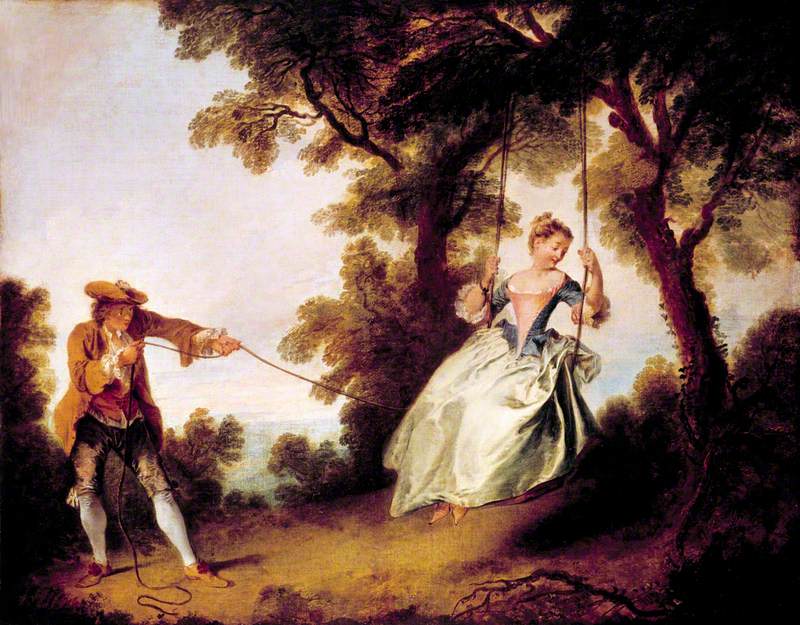
Nicolas Lancret, The Swing (1735). Collection of the Victoria and Albert Museum, London.
Over his career, Fragonard made three paintings in which women appear on swings. He also painted one composition that shows a girl on a seesaw. He wasn’t the only—or even the first—artist to do so. “Joseph Christophe painted the themes as part of the redecoration undertaken at the Versailles Menagerie in 1699 and Jacques van Schuppan used it for a picture he exhibited in the Salon of 1704,” wrote Posner. Watteau further cemented the genre with his own paintings featuring women on swings in the years preceding Fragonard.
By the mid-18th century, swings had become a favored artistic motif to illustrate the leisure life of the aristocratic class, though the gender divide wasn’t equal.
“Women swinging are almost the rule… and nowhere and at no time were they so brilliantly depicted as in 18th century France,” Posner elaborated. Swinging had become a metaphor for flirtation, and more acutely, women’s perceived inconstancy or fickleness when it came to matters of the heart. “The passivity of the woman on the swing and the control exercised by the man in initiating and continuing her ride made the image a natural metaphor for traditional courtship behavior,” wrote Posner. Meanwhile, the act of swinging to and fro reflected, it was believed, women’s “swings” of emotion.

Jean-Honoré Fragonard’s The Swing (ca. 1775/1780). Collection of the National Gallery of Art, Washington D.C.
The swing also offered physical associations, as Posner famously concluded in his 1982 essay. “Swinging not only quickens that heartbeat, it even more obviously sets the body in rhythmic motion. Naturally, it came to serve a quite specific erotic metaphor,” he explained, “Swinging as symbolically synonymous with lovemaking eventually became established in the popular culture of the 18th and 19th centuries, and the meaning has persisted into our time.”
In the years since Posner’s essay, art historians have elaborated on this interpretation, often making note of the suitor’s extended arm and the woman’s pink dress, perhaps suggestive of male and female sexual anatomy.
“With the exhilaration of vertigo play, swinging permitted occasions of sexual disorder where uninhibited positions revealed the body and spectators glimpsed views that were usually hidden from sight,” added art historian Jennifer Milam in her essay “Playful Constructions and Fragonard’s Swinging Scenes” (2000).
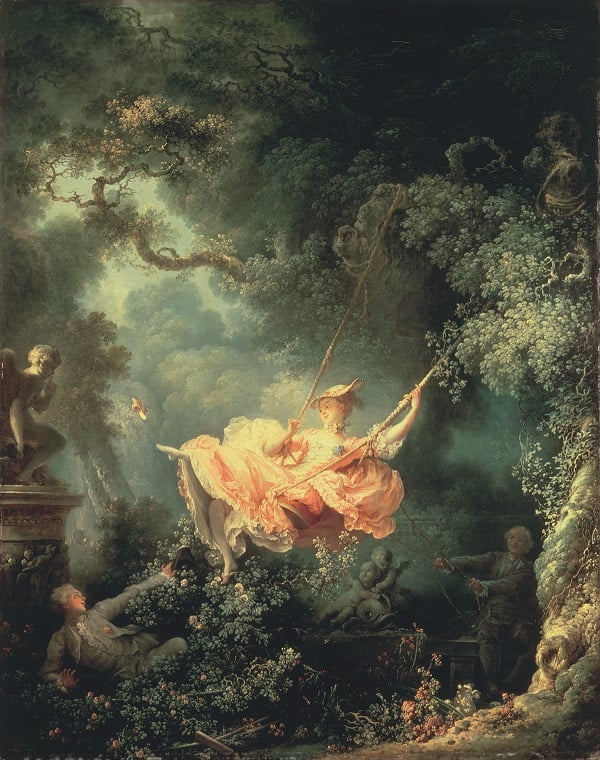
Jean-Honoré Fragonard, The Happy Accidents of the Swing (c.1767). Image: Courtesy of New Directions.
The Swing’s coy game of back-and-forth functions on two levels. First, it occurs in the flirtatious subject matter of the young woman, her lover, and the older man who is perhaps her cuckold husband. But this triangulation exists on another level between the artist, the viewer, and the painting itself, as Fragonard tests both his skills as a painter and the perceptions of his audience. “By elaborating on the notion of swinging as a game of visual distortion, Fragonard manipulated and transformed emblematic conventions in order to muse on the vertiginous experience occasioned by a playful application of paint,” wrote Milan in her essay.
Fragonard does this in several ways. Fragonard’s The Swing has often been lauded for its naturalism—the ravishing flowers and trees and the perceived realism of the figures’ emotions. Nevertheless, the image is highly constructed—allegorical rather than historical. While the painting was commissioned as a portrait of the Baron and his mistress, the figures Fragonard presents are wholly imagined. “The main actors are generalized types of young lovers and do not seem identifiable as specific persons,” Posner concluded. Similarly, Fragonard playfully brings to life intimate objects—his Cupid imbues the work with a life-like sense of urgency, while simultaneously pulling the viewer into the drama of the moment. Similarly, in Cupid’s allusion to Pomadour, the sculpture pulls history into the fictitious scene. Ultimately that is the goal—Fragonard engages the viewer in a game of teasing push-and-pull where the real and the imagined collide.